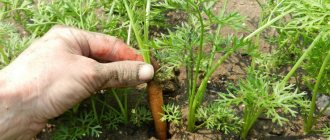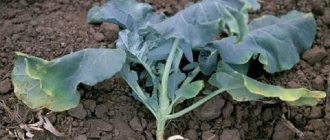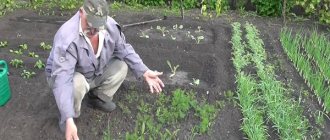Why are carrots gnarled? Why are carrots horned and hairy? Why do carrots burst? Why are carrots tasteless? – these are the questions hundreds of beginning gardeners ask themselves at the end of the season, after harvesting the carrot bed. It’s a terrible shame to spend the whole summer caring for, watering, weeding, and instead of straight and long carrots, end up with ugly roots.
To avoid or not repeat a similar situation, it is better to understand in advance, even before sowing the seeds, the causes of clumsy root crops and try to eliminate them. This is a useful thing that we will do today...
There are five main reasons for poor quality carrot harvest.
Reason one: heavy soil
Just like turnips or celery root, carrots love loose, easily permeable soil.
In clayey, rocky, podzolic, heavy areas, it fails to grow even root crops; it becomes deformed, “bending around” compactions in the soil. Therefore, when preparing a carrot bed in the fall, it is recommended to mix the soil with sand, peat, rotted sawdust and humus. For one bed take a bucket of sand and peat (or sawdust) and 3-4 kilograms of humus. A warm bed or organic trench in which cucumbers or tomatoes previously grew can also serve as an excellent bed for carrots.
The main reasons why carrots grow ugly - gnarled, horned and branched
Improper planting and care of carrots lead to the fact that the root crops eventually become deformed, branch and grow gnarled and horned. Next, we will name specific reasons - errors during planting and care that cause these negative consequences.
Wrong place to plant: unsuitable soil, lack of bed preparation
Firstly, if the soil in which the carrots will be planted is too dense and clayey,
carrots can grow branched (horned).
Therefore, before planting carrots, you should properly prepare the bed for it: if you have very heavy soil, then you need to add raising agents - sand, compost, humus and/or peat. And first you can plant and mow green manure .
By the way! When preparing a bed for planting carrots, it is necessary to remove all weeds , break up all lumps of earth and carefully remove all large pebbles from the ground , which can also cause deformation of the carrots, i.e. the root crop will not be able to break through dense clods of earth and large pebbles. As a result, it will simply go around them and bend.
It is also known that carrots do not tolerate fresh manure and do not really like soil
(they need to be applied in the fall, and not in the spring right before sowing the seeds), as well as
potassium chloride fertilizers - potassium chloride and potassium salt.
I have an opinion! If you sow carrots in a bed that has previously been fertilized with fresh manure (even in the fall), the root crops may grow ugly and gnarled.
It happens that gnarliness of carrots can be caused by excess nitrogen (but rarely).
Thinning: complete absence or untimely
Root crops can grow deformed (crooked) due to the initial excessive density of plantings and lack of thinning . As a result, root crops cannot develop normally, sufficient nutrition and space required for root growth, but only interfere with growth = deform each other .
Note! The site has a detailed article on when and how to properly thin carrots .
However, the thinning must be performed on time . If you miss the right moment and the root crops noticeably increase in size before thinning, then you can simply damage nearby root crops, which will cause their deformation and loss of quality appearance.
Note! The fact is that damage to carrot roots leads to the fact that the growth of the main root crop is suspended, and instead the development of lateral roots and the formation of a branched root crop .
Thus, correct and timely thinning allows you to grow beautiful and large carrots of approximately the same size.
Lack of watering
If the carrots experience a lack of moisture due to frequent but superficial watering , this may cause the root crop to form a large number of adventitious (additional) roots and the carrots will begin to branch. The fact is that it forms additional roots that will seek and extract the necessary moisture in the surface layer of soil.
Remember! The main principle of proper watering of carrots is abundantly (i.e. you need to deeply saturate the soil), but infrequently and always regularly.
Reason two: improper watering
Untimely, incorrect, excess watering leads to the appearance of horned, small and shaggy carrots.
Bursting and cracked carrots are also the result of waterlogging. Two factors are important when watering carrots: regularity and depth. It is better to water rarely, while wetting the soil 20-30 centimeters deep, than every day, splashing water over the surface of the bed. The roots are always in search of moisture, and if water is on the surface, the carrot will grow a huge number of small roots to absorb it. The result is small, shaggy, hairy carrots.
After the process of root crop formation is completed (in August), carrots are not watered at all until harvesting. During this period, root vegetables will gain sugar. Too much rain or unnecessary watering at this time can cause cracked carrots. Carrots also often burst when they receive a large amount of moisture after a prolonged drought.
It is usually recommended to water carrots frequently and abundantly in the first month after planting. Then, in dry and hot weather, twice a week is enough, making sure to deeply wet the soil. And after the formation of root crops, watering is stopped altogether.
How to grow smooth, beautiful carrots
To get a good quality carrot harvest, you should pay special attention to two stages of plant development.
Two critical stages of carrot development during which the root becomes deformed:
- First stage . Curvature occurs due to lack of moisture, heavy soils and excess nitrogen.
- Second half of the growing season. At this stage, horned carrots often form due to lack of moisture.
It is important to comply with sowing dates to obtain a high-quality harvest. If the temperature after sowing is below + 8°C, the likelihood of deformation of root crops increases. If the temperature is above + 25°C, then development will slow down.
Important! When sowing in winter, special varieties of carrots are chosen. Because the soil settles in winter.
The choice of location also affects the increase in the quality of the crop. Consider the following cultural features:
- the bed is placed in a lighted place;
- use loose soil with neutral acidity;
- follow the rules of crop rotation: the best predecessors are potatoes, onions, tomatoes.
Another important point when growing carrots is preparing the seeds for sowing. To get healthy carrot shoots, use the following methods for preparing seeds:
- Soaking method. Prepare a solution: 0.5 tsp. complex fertilizer and 0.5 tsp. potassium permanganate is dissolved in 1 liter of water. Soak the seeds for a day in this solution, after which they are sown.
- Hardening method. The seeds are placed in a cloth and a week before sowing, they are buried in the ground to a depth of 20 cm. The seeds are taken out on the day of sowing, dried and sown.
Excellent Seed Germination! How to Prepare Carrot Seeds for Planting.
To avoid crowding of crops, they are drained or purchased ready-made.
Important. The belt sowing method is also used. Seeds are glued to a strip of paper at a distance of 7-10 cm, and the strip is laid in a row.
Secrets of growing smooth, beautiful carrots:
- follow the rules of agricultural technology;
- do not sow carrots after herbs;
- lightly hill up the crops after weeding;
- take care of crops in a timely manner;
- follow the watering rules;
- treat crops against diseases and pests.
Reason three: lack of organic matter
Carrots seem to be considered an unpretentious crop, but they will never mind a good layer of humus in the soil.
Soil rich in organic matter is always loose, nutritious, and permeable to water—carrot “monsters” are practically never found on such soil. However, not all organic matter is equally beneficial for carrots. There is no need to add fresh manure or droppings, ash, or eggshells under the carrots; they do not favor them. For carrots, well-rotted, processed organic fertilizers would be ideal, which is why they do well in organic beds of the third year after tomatoes, cabbage or other good predecessors.
How to feed carrots to make them sweet
To grow sweet carrots, fertilizing is necessary. According to many gardeners, wood ash will add sweetness. The potassium contained in its composition affects the taste. Ash is added to the soil before digging, and it is also used to dust plants or sprinkle it between rows. Thus, they kill “two birds with one stone”: the ash will supply the plant with potassium and at the same time protect it from the carrot fly. Experienced gardeners also believe that such fertilizer improves the keeping quality of root crops.
In addition, proper watering gives juiciness and sweetness. Of course, the frequency of watering depends on weather conditions (abundance or lack of rain) and the structure of the soil. On sandy and sandy loam soils it is necessary to water every week and very generously. Fertile and oily soil is also watered every week, but little by little.
But there are different opinions about the frequency of watering carrots. I found this review in the comments to one article.
Carrots are one of those crops that do not require additional watering. As soon as the leaves close together between the rows (before this point, you should water if it is very dry). Its root tends downward (the root system is taprooted) - this is how nature intended it - there is always water in the lower layers of the soil, despite the fact that it may be dry outside. By watering carrots, we disrupt the natural growth program - it makes no sense for it to strive down when there is water closer to the surface - this is how freaks are born. And I simply compensate for the lack of moisture during the dry period by having mulch between the rows of carrots.
I don’t know how you will feel about this opinion, although there is some truth here too. But I water my plot exactly as I told you. And I very rarely grow ugly carrots.
Reason four: root damage
Much more often than it seems, horned carrots occur due to damage to the root at the very beginning of growth.
Carrots have this weakness: the slightest touch to the root, and the root crop will begin to split into two. Therefore, carrots are never replanted - it is useless. When can something like this happen? Firstly, if we decided to soak the seeds before planting, but they managed to germinate. For many other crops this is an ideal option, but this trick won’t work with carrots. Sprouted fragile roots are very easy to damage when planting.
Secondly, in dry weather and lack of moisture in the first month of seedling growth. When the bed dries out, the tips of the roots of young plants are the first to suffer.
Thirdly, in case of careless thinning of seedlings. Especially if they were not in a hurry with thinning and began to do it much later than the appearance of the first real leaf.
Finally, the root can become a tasty morsel for pests.
Advice from experienced gardeners
Many experienced gardeners share their methods for solving the problem of carrot deformation.
Let us highlight the main ones:
- the soil must be restored, so this vegetable can be planted in its original place at least a year after the previous planting. This will allow the soil to replenish lost resources, it will become soft, and this will prevent the appearance of horned carrots;
- avoid excess humus in the soil, because the root crop does not tolerate manure well, which causes bifurcation;
- row spacing must be at least 25 cm;
- Be sure to strictly adhere to the watering rules and do not forget to thin out the carrots on time.
Important! Watering should be done strictly along the rows and trenches. Thinning should be done every 4 cm, then the carrots will not be clumsy.
Knowing all the causes and problems of carrot deformation, as well as methods and techniques to combat it, you can easily prevent any unwanted changes in the vegetable.
Reason five: unsuitable fertilizers
Not only do carrots have a difficult relationship with organic fertilizers, but not everything is smooth with mineral fertilizers either.
You should not feed carrots with ash, dolomite flour and potassium chloride. And all other fertilizers (if there is a desire to apply them) are best applied in the fall when preparing the future bed. It is better to underfeed than to overfeed - this rule for carrots works one hundred percent.
We hope that now gnarled, shaggy and cracked carrots in your beds will become less and less common.
We wish you success and great harvests!
Why do carrots turn green? Insulating the front door
Why do carrots turn green? Why does this happen and how to avoid it
Some gardeners believe that carrots with a green “top” are poisonous. In fact, this is not so, because the green color of the vegetable is given by ordinary chlorophyll. So such carrots will not harm your health in any way. Another thing is that eating it is unpleasant. Therefore, whether to eat such root vegetables or not is up to you to decide. In addition, green carrots are also not suitable for sale - they simply do not have a marketable appearance.
Why is this happening?
The top part of the carrot changes color when the carrot has an elongated shape (this is usually characteristic of certain varieties, for example, Nantes or Flacque carrots).
Fruits that protrude too much from the ground can also turn green. This happens after watering, when the soil is washed out or settles.
When choosing varieties or hybrids of carrots that are not resistant to greening of the root head, you cannot be sure that the harvest will be completely ideal.
Carrots may turn green due to mechanical damage during cultivation of the soil around the plants. This also applies to stressful situations for this vegetable.
Wrong variety of carrots
It's not the variety itself; or rather, it's not the seeds or poor selection that are to blame, it's the discrepancy between the growing conditions and varietal requirements. For example, we have already mentioned sowing carrots before winter, but it should be noted that during the winter the soil in the beds becomes compacted, and if it is not light enough, then even with high-quality pre-sowing cultivation, the carrots can be deformed. This usually applies to large-fruited varieties; the deformation is insignificant; only the tip of the root crop may be bent.
How to fix
Carefully prepare the beds in the fall and sow in fluffy soil. Select varieties for winter sowing that are not large, but suitable for salads and for bunches.
What problems may arise when growing carrots?
Carrots are grown in almost every country house. This is not to say that this vegetable is too demanding and difficult to care for, like, for example, a tomato or eggplant. However, sometimes it also causes gardeners a lot of trouble. What difficulties can await those who start growing carrots?
Poor seed germination. There may be several reasons for this. The most common is that you purchased low-quality seed material. To avoid this, try to purchase seeds only from reliable and trusted sellers. Another possible reason is unfavorable weather that occurred after sowing. Both drought and heavy rains can cause seed death. There is only one way out - to replant everything again.
- Cracks on the root crop. This is not just an external defect. Such carrots store worse and are more difficult to clean. Excessive watering or heavy rains can lead to this, especially if it has been dry for a long time before. In addition to irregular moisture, carrots can also crack due to excess nitrogen.
- Greening of the root crop. Usually the very top part turns green. The green color indicates that a toxic substance, solanine, has begun to accumulate in the carrots. The reason is the sun's rays that fall on the part of the root crop that is not covered with soil. To avoid this problem, carrots need to be hilled up from time to time, covering the bare areas with earth.
- Diseases. Carrots are most often affected by various types of rot: brown, wet, white, black, etc. The main cause of these problems is excessive moisture levels during the growing season or during storage. Insufficient levels of potassium in the soil can also cause the disease.
- Pests. Yes, unfortunately, we are not the only ones who love carrots. We also have competitors - carrot aphid, psyllid and carrot fly. Here we cannot do without a tough struggle: either we give them, or they give us the carrot.
Problem solving methods
It is necessary not only to know the causes of the problem, but also to be able to deal with them or prevent them. To do this, it is important to highlight the main list of methods for solving problems associated with the ugliness and deformation of carrots.
Here are the main ones:
- Thorough preparation of the planting site: in the fall - loosen the soil well, in the spring - repeat the procedure.
- Organizing the correct watering regime.
- Maintaining distance when sowing.
- Timely harvesting.
If you follow all the instructions at the same time, you can not only improve the quality of the product, but also significantly increase the yield.
In addition to the main methods of control, there are a number of auxiliary actions that help save the fetus from deformation.
These include:
- mandatory use of complex fertilizers;
- fertilizing the soil in the fall.
Unsuitable soil and violation of crop rotation
When growing carrots, it is important to comply with soil requirements. Although the vegetable crop is undemanding to the fertility of the soil, if vegetables are grown in heavy soil filled with clay and stones, the likelihood that horned or gnarled carrots will grow increases significantly. The reason for this is the need for the plant, in the process of rooting and development of the root crop, to overcome obstacles encountered in the path of the root system in the form of compactions.
When growing carrots in heavy soils with a heterogeneous structure, the growth of vegetables changes direction, resulting in gnarled and horned carrots.
The soil that is unsuitable for the proper formation of carrot fruits is one that has been fertilized with unrotted manure or unripe humus. Horned and shaggy carrots grow when limestone, ash powder, potassium chloride are added to the soil immediately before planting, or an excess of calcium is allowed.
Organic fertilizers are applied in advance, a year before planting carrots, when growing predecessors.
The appearance of deformed carrot fruits prevents the soil from mixing with river sand, which promotes the development of vegetables in the correct forms. It is also taken into account that, in order to avoid the deformity of the fruit, carrots are not planted immediately in loosened soil, but are waited until the soil settles.
Crop rotation violation
Among the reasons for the deformation of vegetables and the appearance of ugly carrots, non-compliance with crop rotation is noted. Thus, it is recommended to choose a planting area where tomatoes, cucumbers, onions or garlic have grown before carrot plantings.











